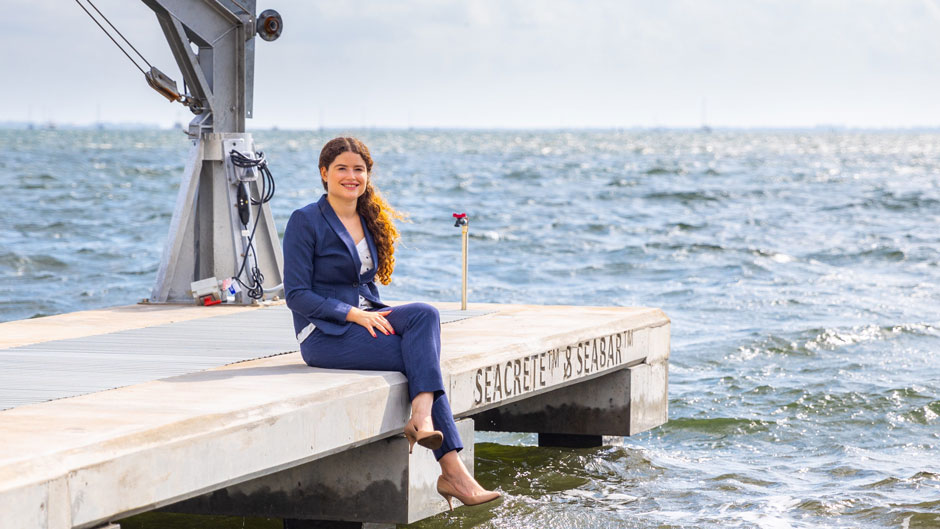With concrete pilings and slabs on its deck, the massive crane barge arrived at the waterfront home around midday, anchoring just offshore. Then came the heavy work, when an engineer used the crane’s lifting hook to put the pieces in place.
It was late April of 2019, and Coconut Grove resident Alan Sirkin was getting a new boat dock nearly two years after powerful Hurricane Irma destroyed his previous one.
Ordinarily, there’s nothing novel about the installation of such a structure. But in this case, the method and the materials used to construct the dock made the whole building endeavor unique.
“It’s a prototype,” said Vanessa Benzecry, the University of Miami College of Engineering graduate student who, working closely with Miami-based Dock and Marine Construction, spearheaded the entire project—from conception to design.
Innovation is pervasive in all of the dock’s parts, “and that’s why we’re calling it an iDock,” Benzecry explained. Its pilings and deck slabs, for example, are made of concrete that was mixed with seawater.
“Freshwater is scarce,” said the civil engineering Ph.D. student from Manaus, Brazil in the heart of the Amazon Rainforest, alluding to the fact that only 2.5 percent of the Earth’s water is freshwater. “It makes no sense to use a valuable resource that’s so essential to life but is in such short supply.”
Seawater from the Rosenstiel School of Marine and Atmospheric Science was used to mix the special concrete, which is called Seacon.
Researchers at the College of Engineering collaborated with scientists in the U.S. and Italy to develop the concrete, and it is part of the trend toward green building. But it’s not the Seacon alone that makes the iDock a sustainable construction project. Special rebars inside the concrete play an equally important role.
Steel rebars are often used inside concrete for reinforcement. But since seawater can accelerate the corrosion process in steel, Benzecry and her team had to find an alternative—a rebar that could withstand seawater’s corrosive effects.
So they used two types of rebars, reinforcing the dock’s concrete pilings and piling caps with glass fiber-reinforced and basalt fiber-reinforced polymer rebars.
In addition to their non-corrosive qualities, said Benzecry, the special rebars are about one-fourth the weight of steel reinforced rebars of the same size, have a high strength-to-weight ratio, are easy to install and do not conduct electricity.
“It will last a lifetime,” Sirkin said of his new dock, which has a life expectancy of 75 years.
A 1967 graduate of the University of Miami who earned his bachelor’s degree in civil engineering and started a company that developed condominium projects on Miami Beach, Sirkin built the original dock in back of his Coconut Grove home in 1986, only to see Hurricane Andrew destroy it seven years later.
He rebuilt the dock. But years later it would be demolished again when another storm, Hurricane Irma, tore through South Florida in September of 2017, washing away the dock’s wooden deck.
“I didn’t want to keep rebuilding it,” said Sirkin, a longtime supporter of the College of Engineering. “The concrete pilings were over 30 years old, and the saltwater was starting to corrode the steel reinforcement inside the concrete.”
When Antonio Nanni, professor and chair of civil, architectural, and environmental engineering at UM, told him about an innovative dock he and his graduate students had designed, Sirkin green lighted the project, agreeing to have it installed at his home as a prototype.
“I watched the entire construction process,” said Sirkin, comparing the project to using Lego bricks to build a structure.
His analogy is fairly accurate in some respects, for Benzecry and her civil engineering teammates employed a technique that is actually used in bridge construction to build the dock. In a method called accelerated bridge construction, the components for Sirkin’s new dock—the concrete pilings and piling caps and the deck slabs—were precast offsite and then transported to Sirkin’s home via truck and barge, reducing construction time and cutting down on errors that are typically made when concrete is poured at the construction site.
Now, Sirkin has a new showpiece, and he is equally ecstatic that the dock is helping to usher in a new era of sustainable building.
“So many of the seawalls that were built 20, 30 and 40 years ago are starting to fall apart, so it makes no sense to keep rebuilding with the same materials that over time will fall apart,” he said. “This is the way the industry is trending.”
Nanni, whose civil engineering group operates as a National Science Foundation-funded University Cooperative Research Center for the Integration of Composites into Infrastructure, said the dock was actually built to the same load specifications as a pedestrian bridge to demonstrate to the Florida Department of Transportation what can be accomplished using innovative materials and construction methods.
He and his students plan to test a miniature replica of the dock in the Rosenstiel School’s hurricane simulator Sustain laboratory, subjecting it to different wind speeds and wave heights to get a better idea of how marine structures stand up to extreme conditions.

